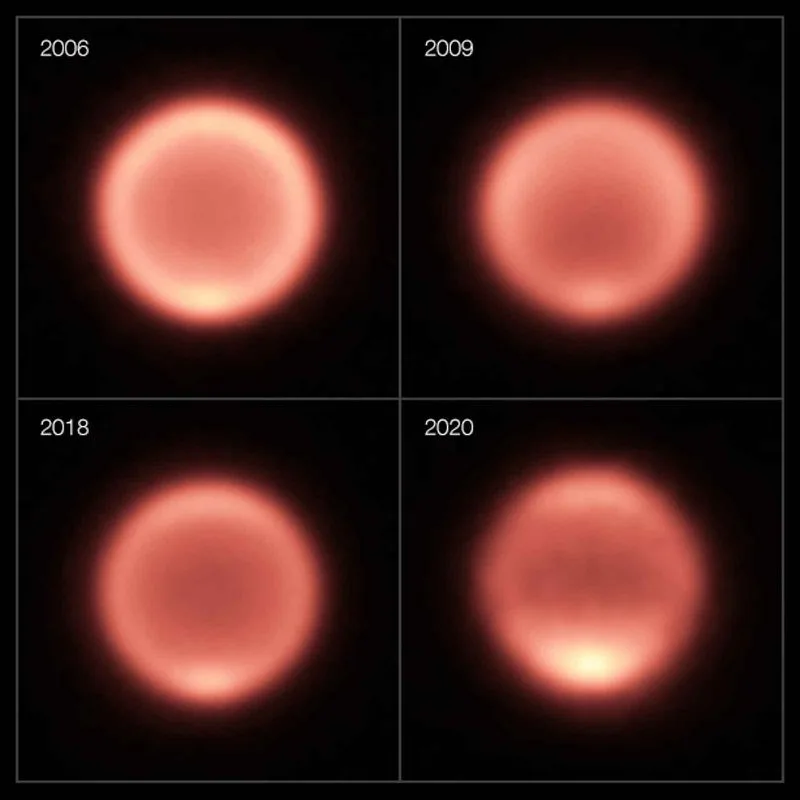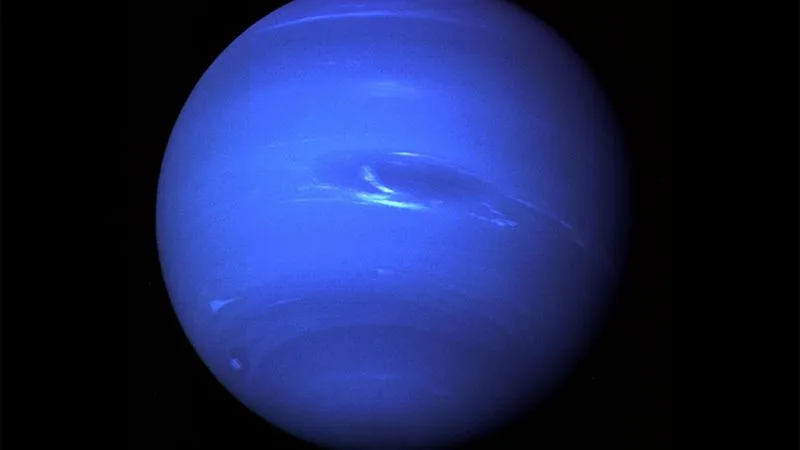The most distant planet in our solar system, Neptune has presented a new mystery.
Frosty Neptune has an average of negative 340 degrees Fahrenheit (negative 220 degrees Celsius), and astronomers still don’t know what caused these temperature shifts.
The planet orbits the Sun at an average distance of 4.498 billion km (2.794 billion miles).and was discovered by the German astronomer Johann Gottfried Galle on 23 September 1846
Astronomers who have been observing Neptune over the past 17 years with several ground-based telescopes have tracked the ice giant’s unexpected drop in global temperature, followed by a sharp warming trend at the planet’s south pole.
Researchers from the University of Leicester, United Kingdom and NASA observed the planet’s temperature from 2003-2020 to understand how its seasons evolve with time.
The researchers relied on a fleet of ground-based telescopes – Chile’s Very Large Telescope and Gemini South telescope, Hawaii’s Subaru Telescope, Keck Telescope, and the Gemini North telescope as well as a space telescope named Spitzer Space Telescope to study Neptune.
The unexpected reversal of the trend in the polar region suggests some interesting atmospheric dynamics are at play, said Heidi B Hammel, the executive vice-president of the Association of Universities for Research in Astronomy.
A year on Neptune lasts about 165 Earth years, so a single season can last about 40 years. It has been summer in Neptune’s southern hemisphere since 2005.
Astronomers decided to track the planet’s atmospheric temperatures once the southern summer solstice occurred that year.
Nearly 100 thermal images of Neptune taken since then showed that much of Neptune gradually cooled, dropping by 14 degrees Fahrenheit (8 degrees Celsius) between 2003 and 2018.
The polar warming has never been observed on Neptune until now.

A study on the phenomenon published Monday in the Planetary Science Journal
“This change was unexpected,” said lead study author Michael Roman, a postdoctoral research associate at the University of Leicester, in a statement.”
Since we have been observing Neptune during its early southern summer, we expected temperatures to be slowly growing warmer, not colder.
Then, a dramatic warming event occurred at Neptune’s south pole between 2018 and 2020 and temperatures rose by 11C. This warm polar vortex completely reversed any cooling that occurred before.
Study coauthor Glenn Orton, senior research scientist at NASA’s Jet Propulsion Laboratory said, our data cover less than half of a Neptune season, so no one was expecting to see large and rapid changes.
“This change was unexpected,” said lead study author Michael Roman, a postdoctoral research associate at the University of Leicester, in a statement. “Since we have been observing Neptune during its early southern summer, we expected temperatures to be slowly growing warmer, not colder.”
Infrared light emitted by Neptune’s stratosphere, or the atmospheric band above the active weather layer, has helped astronomers detect temperature fluctuations.
For now, they have considered that the unexpected changes could be due to a number of factors.
“Temperature variations may be related to seasonal changes in Neptune’s atmospheric chemistry, which can alter how effectively the atmosphere cools,” Roman said.
“But random variability in weather patterns or even a response to the 11-year solar activity cycle may also have an effect.”

More observations will be needed to truly explore these possibilities. The James Webb Space Telescope will observe Uranus and Neptune later this year.
The space observatory’s mid-infrared instrument can map the chemistry and temperatures in Neptune’s atmosphere and could identify what caused the shift. Neptune is more than 30 times as far from the sun as Earth, and it’s the only planet in our solar system that isn’t visible to the naked eye from Earth.
So far, only NASA’s Voyager 2 spacecraft has flown by Neptune up close, which occurred in 1989.”I think Neptune is itself very intriguing to many of us because we still know so little about it,” Roman said. “This all points towards a more complicated picture of Neptune’s atmosphere and how it changes with time.”
Researchers have their hopes pinned on the James Webb Space Telescope launched in December 2021 to provide answers to this mystery.







